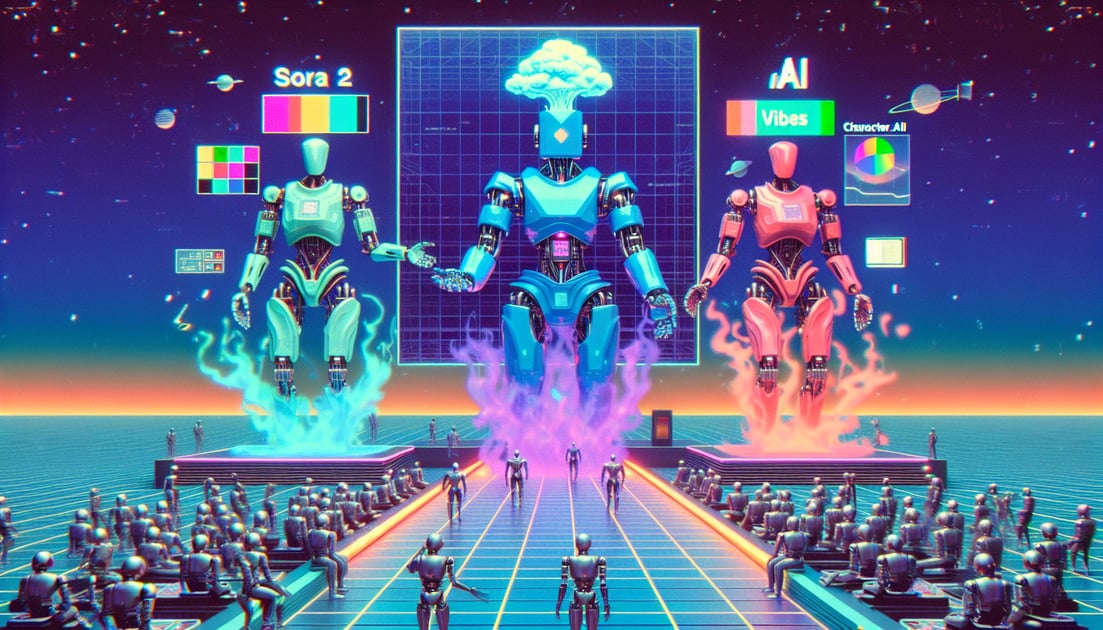
AI Video Goes Social: Sora 2, Vibes, and Character.AI’s Feed Signal a New Platform War
The next battle for attention is here: AI-native video flowing directly into social feeds. This week’s moves frame the fight. OpenAI is pushing with Sora 2, Meta is rolling out Vibes, and Character.AI is launching Feed—three different bets converging on the same screen, your scrolling thumb, and the creator economy that powers it, as reported in a single overview tying these developments together from Mashable.
The AI video social media war begins
According to a broad framing of the moment, the platform contest is moving from model demos to social distribution: OpenAI’s Sora 2, Meta’s Vibes, and Character.AI’s Feed all point to AI video as a social-native format rather than a standalone lab showcase as noted by Mashable.
Why now
Two clocks are ticking: the creator economy’s constant need for fresh formats and the platforms’ need to keep users inside their feeds. The arrival of Sora 2, Vibes, and Feed in the same conversation underscores that both imperatives are converging on AI video per Mashable’s snapshot of the landscape.
OpenAI’s Sora 2: aiming the model at the feed
OpenAI’s next-gen video model, Sora 2, is a signal that the company’s research-grade visuals are being positioned closer to real audience environments, not just studio reels. That framing—Sora 2 in the same breath as social platform features—suggests a run at everyday consumption, where watch time, remixability, and shareability matter most as framed by Mashable.
What to watch from Sora 2
- Latency and length: If AI video is to live in feeds, speed and clip duration will define whether it competes with short-form video.
- Editing and control: Granular prompts, storyboard-like control, or timeline editing—any of these could turn a demo into a daily tool for creators.
- Remix culture: Easy captioning, audio swaps, or shot-to-shot control could unlock collaborative trends.
Sora 2’s appearance alongside social features in the current news cycle is the tell: distribution, not just generation, will decide winners per Mashable’s coverage of the competitive moment.
Meta’s Vibes: social-native AI as a format
Meta’s “Vibes” enters the conversation as a social product, not just a model—precisely the angle that could tilt the field. If Vibes functions as an AI-native format inside Meta’s existing attention engines, it could compress the path from idea to virality. The key point isn’t a spec sheet; it’s that a social giant is stepping into the AI video space with a product explicitly framed for feed dynamics as the Mashable piece highlights.
Meta’s platform playbook
- Distribution advantage: If Vibes integrates natively, Meta could prioritize the format in discovery surfaces.
- Social graph meets AI: Friend graphs and interest graphs might shape which AI videos land in your feed.
- Monetization rails: Existing ad and creator payout systems could quickly incentivize adoption.
The strategic through-line is clear from the coverage: Vibes is a social move in an AI race per Mashable’s summary of the emerging “video social” competition.
Character.AI’s Feed: agents meet audiences
Character.AI’s “Feed” gestures toward something different: AI agents generating for and with communities. A feed suggests ongoing streams of content, interaction loops, and episodic moments—less about one-off clips and more about relationship-building between users and AI personas. Positioned alongside Sora 2 and Vibes, it hints at a new content layer where chat-native identities publish into social rhythms as grouped together by Mashable.
Creator economy implications
- Infinite formats: AI personas can publish continuously, anchoring new micro-genres and serial content.
- Collaboration remix: Human creators might co-produce with agents, accelerating idea pipelines.
- Audience co-creation: Comment-driven prompts could steer episodes in real time.
The fact that “Feed” is discussed in the same breath as mainstream video products shows how quickly agents are becoming publishers as reflected in Mashable’s overview.
The hard problems: safety, rights, and authenticity
As AI video enters social contexts, the familiar challenges intensify. Safety systems and moderation must scale to synthetic, high-velocity video. Rights management and IP licensing need clearer lanes for training data, style emulation, and soundtrack usage. Provenance and authenticity—whether via watermarking or media forensics—will underpin trust, especially when AI output blends seamlessly into feeds. The connective report here is that these products are arriving together, raising these questions right at the point of user attention per the Mashable scene-setter.
Metrics that will matter
- Time-to-publish: minutes from prompt to post.
- Cost per minute: creator-friendly economics for routine use.
- Watch and rewatch: whether AI-native clips hold attention.
- Remix rate: the percentage of content that spawns derivative creations.
These are the numbers that will signal whether Sora 2, Vibes, and Feed are fun demos or foundational formats in the feed era highlighted by Mashable.
What it means for brands and publishers
- Pilot inside the feed: Treat AI video as a native social format—short, iterative, and responsive to comments.
- Build guardrails: Set approval flows, style guides, and rights checks tailored to synthetic media.
- Co-create responsibly: Use AI to draft, then invest human judgment where it counts—message, context, and ethics.
The impetus for this advice is the moment described—AI video tools and social feeds converging in real time, with Sora 2, Vibes, and Feed as early markers as framed by Mashable.
The upshot: AI video is escaping the lab and moving straight into social attention streams. With OpenAI’s Sora 2, Meta’s Vibes, and Character.AI’s Feed appearing together in the discourse, the narrative is shifting from capability to distribution, from demos to defaults in your daily scroll per Mashable’s report. Watch for products that collapse prompt-to-publish, for feeds that privilege AI-native formats, and for creators and communities that turn synthetic video into a living, social language. The war for the AI-native feed is on.